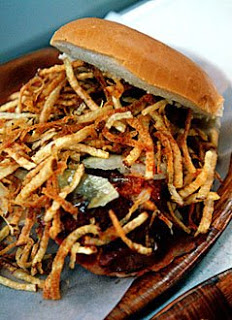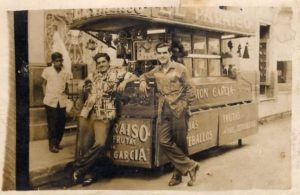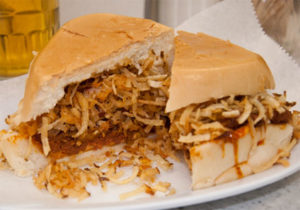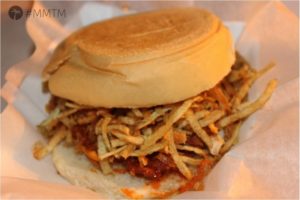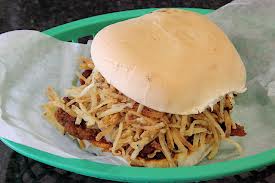 EL PUESTO DE FRITAS, UNA INSTITUCION CUBANA QUE DESAPARECIO TAMBIEN…
EL PUESTO DE FRITAS, UNA INSTITUCION CUBANA QUE DESAPARECIO TAMBIEN…
Hablando de un pasado todavia recordado por una buena cantidad de cubanos eran aquellas bolitas de carne bien condimentada, aplastada y colocada entre dos tapas de pan untadas con mostaza y cátsup y con la provisión correspondiente de malanga o boniato frito y cortado a la juliana, satisfacía el apetito y daba bríos para lo que vendría después, más si se acompañaba de un refresco, un guarapo o una copita de ostiones. Fue el mejor de los inventos para matar el hambre. Un sostén de pobres que terminó imponiéndose entre otras capas de la sociedad, así como en su momento el tasajo y el bacalao, comida de esclavos, invadieron y terminaron por adueñarse de la mesa de los ricos.
En Cuba el eclipse de las fritas comenzó en marzo de 1968, con la llamada «ofensiva revolucionaria» que terminó por eliminar los negocios particulares, por pequeños e insignificantes que fueran. Antes de 1959 tuvo entre las comidas rápidas una preeminencia mayor que los bollitos de carita y las majúas de los puestos de chinos, los perros calientes —llamados entonces hot dog—, las frituras de seso y bacalao, los chicharrones de viento y de pellejo, los tamales… Ocupaba un primer lugar que solo le disputaba el café con leche.
Estaba en consonancia con el gusto del cubano por lo frito, una de las constantes del paladar criollo. Las vidrieras donde se expendía, hechas de madera (o aluminio) y cristal y con un fogón de gas o de luz brillante, daban imagen peculiar a La Habana, y le aportaban uno de sus olores característicos, el olor de las frituras, que rivalizaba con el del aroma dulzón del coñac de las bodegas y el perfume barato de las tardes.
UNA INSTITUCION CUBANA
El puesto de fritas era una de las instituciones inconmovibles del barrio, como lo fueron la bodega, el café y el puesto de chinos y, en otro orden, la quincalla. El bodeguero (también el quincallero) sabía muy bien cómo satisfacer a su clientela sin necesidad de recurrir a estudios de mercado. Los chinos eran famosos por sus helados de frutas y su gama de alimentos ligeros cuyo origen todavía se desconoce, pues no eran chinos ni cubanos ni tampoco parecían proceder de San Francisco de California, por donde pasaba toda la comida china que se conocía en Cuba. Con lo que ellos expendían, la gente no se alimentaba, pero se llenaba, y todo por unos pocos centavos. De ahí que, tanto a los puestos de frita como a los de chinos, se les llamara «casas de socorro». La cosa, sin embargo, se ponía mala cuando no se ganaba ni para la frita, palabra que aquí, como vulgarismo, identificaba a la comida.
Puestos de fritas y friteros famosos hubo muchos en La Habana. De gran demanda gozaban las fritas del puesto ubicado en la bodega La Guajira, en 24 esquina a 25, en el Vedado. También las fritas «de lujo» de los Hermanos García, uno de los puntos donde merendaban los que acudían a los velorios de la funeraria Alfredo Fernández, en Zapata entre Paseo y 2, mientras otros dolientes enjugaban sus lágrimas en Los Chavales, bar situado en Paseo y 29. En los portales de la fonda León, en Diez de Octubre entre Estrada Palma y Luis Estévez, frente al desaparecido cine Tosca, estaba una mujer cuyas fritas se mantienen aún en el imaginario popular, Josefina Siré. En la Quinta Avenida, acera sur entre las dos rotondas, había toda una hilera de esos puestos desplegados ante otra hilera de bares y cabarés de mala muerte. Aunque no lo trabajaba personalmente, el periodista Carlos Lechuga tenía el suyo, de mucho rango y clientela selecta, frente a la cafetería Kasalta, a la entrada del exclusivo reparto Miramar.
No hay duda de que el gran fritero fue Sebastián Carro Seijido. Aristocratizó la frita. Empleó solo los mejores productos. Enseñó a sus empleados a trabajar con limpieza, y, sobre todo, les exigió que, en su trato con los clientes, dieran muestras de una cortesía exquisita, y se empeñó en ganarse la clientela femenina porque era esta la que arrastraba a los niños y a toda la familia. Tanto progresó Sebastián Carro que a fines de los años 50 se daba el lujo de anunciarse en el Libro de oro de la sociedad habanera.
SECRETOS
Hay varios modos de elaborar la frita. El gustado entrepán no tiene una receta única. Hay quien recomienda emplear en su elaboración la misma cantidad de carne de res como de chorizo, siempre molidos, pero eso la haría incosteable, tanto antes como ahora.
Nitza Villapol recomendaba el empleo del huevo batido en su composición. Otros emplean migas de pan mojadas en leche para dar consistencia a la masa, que preparan en una proporción de tres partes de carne de res, molida, por una de carne de cerdo, igualmente molida. Sebastián aglutinaba de igual manera y con huevo su conjunto, que elaboraba de carne de res y picadillo de cerdo, en iguales cantidades. En todos los casos resultaba importante el empleo del pimentón español, que le daba a la frita un sabor característico. En las fritas, Sebastián empleaba pan de acemita, y para los panes con bisté, que también ofertaba, empleaba el pan de flauta hecho con manteca de cerdo que expendía la panadería La Francesa, en Águila entre Reina y Dragones. Eran bistés de cañada que pasaban por una maquinita que los porcionaba sin partirlos, para facilidad del cliente.
Porque Sebastián no solo ofertó la cubanísima frita en sus establecimientos. También el bisté y la costilla de cerdo. La empanada de bonito. El pan con tortilla, que se preparaba solo con huevos criollos. El perro caliente. Y los batidos elaborados invariablemente con la leche de la vaquería Las Niveas, propiedad del ya mencionado Carlos Lechuga. En el hot dog y en la frita estaba el fuerte de Sebastián. De ahí que el lema de su negocio fuera: «Fritas deliciosas. Exquisitos hot dog».
En sus establecimientos nunca se utilizó el pan de un día para otro; era siempre fresco. Y en el acompañamiento del plato, Sebastián sustituía la papa por el boniato. Se cortaba a la juliana, se pasaba por una máquina que le daba consistencia de fideos y se freían. Se colocaban después, junto con la frita, entre las dos tapas de pan.
Por lo que decimos los cubanos desde dentro y fuera de Cuba…Cualquier tiempo pasado fue mejor!
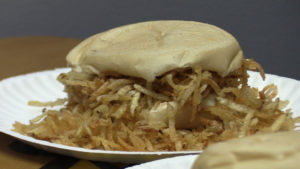 EL PUESTO DE FRITAS, A CUBAN INSTITUTION THAT ALSO DISAPPEARED …
EL PUESTO DE FRITAS, A CUBAN INSTITUTION THAT ALSO DISAPPEARED …
Speaking of a past still remembered by a good number of Cubans were those balls of well-seasoned meat, crushed and placed between two covers of bread spread with mustard and ketchup and with the corresponding supply of fried taro or sweet potato and cut julienne, satisfied the appetite and gave vigor for what would come later, more if accompanied by a soda, a guarapo or a glass of oysters. It was the best of inventions to kill hunger. A support for the poor that ended up being imposed among other layers of society, just as at the time the jerked beef and cod, slaves’ food, invaded and ended up taking over the table of the rich.
In Cuba the eclipse of the fritas began in March 1968, with the so-called “revolutionary offensive” that ended up eliminating private businesses, however small and insignificant. Before 1959 he had among the fast foods a greater pre-eminence than the little cakes and the majüas of the Chinese stalls, the hot dogs -called then hot dog-, the fried fish and cod, the fried pork and skin pork, the tamales … He occupied a first place that only he disputed the coffee with milk.
It was in keeping with the Cuban’s taste for fried, one of the constants of the palate of the Creole. The stained glass windows where it was sold, made of wood (or aluminum) and glass and with a gas or bright light stove, gave a peculiar image to Havana, and gave it one of its characteristic odors, the smell of fried foods, which rivaled with the sweet aroma of the cognac of the cellars and the cheap perfume of the afternoons.
A CUBAN INSTITUTION
The fritas stand was one of the neighborhood’s unshakeable institutions, as were the winery, the coffee shop and the Chinese stand and, in another order, the quincalla. The winemaker (also the ironmonger) knew very well how to satisfy his clientele without having to resort to market studies. The Chinese were famous for their fruit ice cream and their range of light foods whose origin is still unknown, because they were not Chinese or Cuban nor did they seem to come from San Francisco de California, where all the Chinese food that was known in Cuba passed. With what they were selling, people did not feed, but it filled up, and all for a few cents. Hence, both fried and Chinese stands were called “houses of rescue”. The thing, however, became bad when it was not earned even for fried, a word that here, as vulgarity, identified food.
There were many fried and fried fritters in Havana. Of great demand enjoyed the fritas of the position located in the winery La Guajira, in 24 corner to 25, in Vedado. Also the “luxury” fries of the García Brothers, one of the places where those who attended the funerals of the Alfredo Fernández funeral home, in Zapata between Paseo and 2, while other mourners wiped their tears in Los Chavales, bar located in Stroll and 29. In the portals of the Fonda León, in Diez de Octubre between Estrada Palma and Luis Estévez, in front of the disappeared Tosca cinema, there was a woman whose fries are still in the popular imagination, Josefina Siré. On Fifth Avenue, south sidewalk between the two roundabouts, there was a whole row of those stalls deployed before another row of bars and shabby cabarets. Although he did not work it personally, the journalist Carlos Lechuga had his own, of high rank and select clientele, in front of the cafeteria Kasalta, at the entrance of the exclusive cast Miramar.
There is no doubt that the great fritero was Sebastián Carro Seijido. Aristocratized fried. He used only the best products. He taught his employees to work with cleanliness, and, above all, he demanded that, in his dealings with clients, they show signs of exquisite courtesy, and he insisted on winning the female clientele because it was this that dragged the children already the whole family. So much progressed Sebastián Carro that at the end of the 50s he had the luxury of announcing himself in the Golden Book of Havana society.
SECRETS
There are several ways to make fried. The beloved entrepán does not have a unique recipe. Some people recommend using the same amount of beef in their preparation as chorizo, always ground, but that would make it unaffordable, both before and now.
Nitza Villapol recommended the use of beaten egg in its composition. Others use bread crumbs dipped in milk to give consistency to the dough, which they prepare in a ratio of three parts of ground beef, to one of pork meat, equally ground. Sebastian agglutinated in the same way and with egg his group, that elaborated of meat of beef and picadillo of pig, in equal quantities. In all cases it was important to use Spanish paprika, which gave the frit a characteristic flavor. In the fritas, Sebastián used acemita bread, and for the loaves with bisté, that also it offered, it used the bread of flute made with lard that the La Francesa bakery expended, in Eagle between Reina and Dragons. They were steers of gorge that passed through a little machine that was serving them without splitting them, for the ease of the client.
Because Sebastian not only offered the very Cuban fried in their establishments. Also the steak and the pork rib. The bonito pie. The bread with tortilla, which was prepared only with creole eggs. The hot dog And the smoothies made invariably with milk from the dairy Niveas, owned by the aforementioned Carlos Lechuga. In the hot dog and fried was the fort of Sebastian. Hence, the motto of his business was: “Delicious fries. Exquisite hot dog ».
In their establishments the bread was never used from one day to another; It was always fresh. And in the accompaniment of the dish, Sebastian replaced the potato with the sweet potato. It was cut on julienne, it was passed through a machine that gave it the consistency of noodles and fried. They were then placed, together with the frit, between the two bread tops.
For what we say Cubans from inside and outside Cuba … Any time past was better!
Agencies/ Radio Reloj/ Ciro Bianchi/ Extractos/ Excerpts/ Internet Photos/ Arnoldo Varona/ www.TheCubanhistory.com
THE CUBAN HISTORY, HOLLYWOOD.



 < EL PUESTO DE FRITAS, a Cuban Institution That Also Disappeared...
< EL PUESTO DE FRITAS, a Cuban Institution That Also Disappeared...